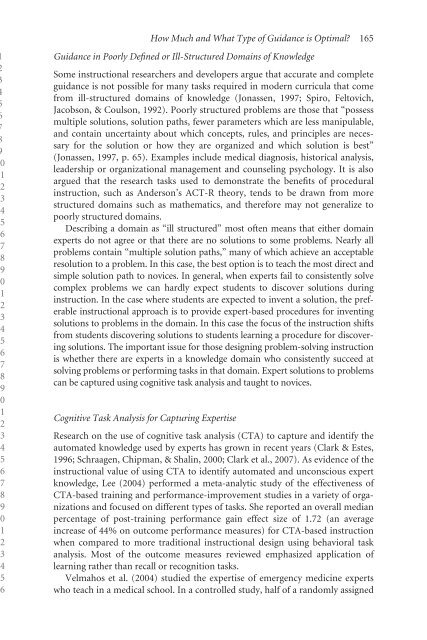9 How Much and What Type of Guidance is Optimal for Learning ...
9 How Much and What Type of Guidance is Optimal for Learning ...
9 How Much and What Type of Guidance is Optimal for Learning ...
Create successful ePaper yourself
Turn your PDF publications into a flip-book with our unique Google optimized e-Paper software.
<strong>How</strong> <strong>Much</strong> <strong>and</strong> <strong>What</strong> <strong>Type</strong> <strong>of</strong> <strong>Guidance</strong> <strong>is</strong> <strong>Optimal</strong>? 1650123456789012345678901234567890123456<strong>Guidance</strong> in Poorly Defined or Ill- Structured Domains <strong>of</strong> KnowledgeSome instructional researchers <strong>and</strong> developers argue that accurate <strong>and</strong> completeguidance <strong>is</strong> not possible <strong>for</strong> many tasks required in modern curricula that comefrom ill- structured domains <strong>of</strong> knowledge (Jonassen, 1997; Spiro, Feltovich,Jacobson, & Coulson, 1992). Poorly structured problems are those that “possessmultiple solutions, solution paths, fewer parameters which are less manipulable,<strong>and</strong> contain uncertainty about which concepts, rules, <strong>and</strong> principles are necessary<strong>for</strong> the solution or how they are organized <strong>and</strong> which solution <strong>is</strong> best”(Jonassen, 1997, p. 65). Examples include medical diagnos<strong>is</strong>, h<strong>is</strong>torical analys<strong>is</strong>,leadership or organizational management <strong>and</strong> counseling psychology. It <strong>is</strong> alsoargued that the research tasks used to demonstrate the benefits <strong>of</strong> proceduralinstruction, such as Anderson’s ACT- R theory, tends to be drawn from morestructured domains such as mathematics, <strong>and</strong> there<strong>for</strong>e may not generalize topoorly structured domains.Describing a domain as “ill structured” most <strong>of</strong>ten means that either domainexperts do not agree or that there are no solutions to some problems. Nearly allproblems contain “multiple solution paths,” many <strong>of</strong> which achieve an acceptableresolution to a problem. In th<strong>is</strong> case, the best option <strong>is</strong> to teach the most direct <strong>and</strong>simple solution path to novices. In general, when experts fail to cons<strong>is</strong>tently solvecomplex problems we can hardly expect students to d<strong>is</strong>cover solutions duringinstruction. In the case where students are expected to invent a solution, the preferableinstructional approach <strong>is</strong> to provide expert- based procedures <strong>for</strong> inventingsolutions to problems in the domain. In th<strong>is</strong> case the focus <strong>of</strong> the instruction shiftsfrom students d<strong>is</strong>covering solutions to students learning a procedure <strong>for</strong> d<strong>is</strong>coveringsolutions. The important <strong>is</strong>sue <strong>for</strong> those designing problem- solving instruction<strong>is</strong> whether there are experts in a knowledge domain who cons<strong>is</strong>tently succeed atsolving problems or per<strong>for</strong>ming tasks in that domain. Expert solutions to problemscan be captured using cognitive task analys<strong>is</strong> <strong>and</strong> taught to novices.Cognitive Task Analys<strong>is</strong> <strong>for</strong> Capturing Expert<strong>is</strong>eResearch on the use <strong>of</strong> cognitive task analys<strong>is</strong> (CTA) to capture <strong>and</strong> identify theautomated knowledge used by experts has grown in recent years (Clark & Estes,1996; Schraagen, Chipman, & Shalin, 2000; Clark et al., 2007). As evidence <strong>of</strong> theinstructional value <strong>of</strong> using CTA to identify automated <strong>and</strong> unconscious expertknowledge, Lee (2004) per<strong>for</strong>med a meta- analytic study <strong>of</strong> the effectiveness <strong>of</strong>CTA- based training <strong>and</strong> per<strong>for</strong>mance- improvement studies in a variety <strong>of</strong> organizations<strong>and</strong> focused on different types <strong>of</strong> tasks. She reported an overall medianpercentage <strong>of</strong> post- training per<strong>for</strong>mance gain effect size <strong>of</strong> 1.72 (an averageincrease <strong>of</strong> 44% on outcome per<strong>for</strong>mance measures) <strong>for</strong> CTA- based instructionwhen compared to more traditional instructional design using behavioral taskanalys<strong>is</strong>. Most <strong>of</strong> the outcome measures reviewed emphasized application <strong>of</strong>learning rather than recall or recognition tasks.Velmahos et al. (2004) studied the expert<strong>is</strong>e <strong>of</strong> emergency medicine expertswho teach in a medical school. In a controlled study, half <strong>of</strong> a r<strong>and</strong>omly assigned
















